Countries that drive on the left
66% of the total populace (163 nations and domains) drive on the right, while the excess 34% (76 nations and regions) drive on the left. As of now, all nations have uniform principles on driving with the exception of China, which was a totally right-driving country until retaining left-driving Hong Kong in 1997 and Macau in 1999 (which brings about a really fascinating looking line crossing when one crosses into central area China and needs to move to another lane). Nations switch driving bearings surprisingly frequently; simply last year, Samoa changed to driving on the left following hundred years of driving on the right to permit its buyer to import vehicles all the more inexpensively from left-driving Australia and New Zealand as opposed to the right-driving US. Starting around 1967, five nations have exchanged driving headings; the other four to do as such (Sweden 1967, Iceland 1968, Burma 1970, Ghana 1974) headed down the contrary path, joining most of nations all over the planet in driving on the right-hand roadside. In the beginning of vehicle driving, exchanging sides was substantially more typical as nations worked their guidelines out.
In most of the world’s countries, including the United States, people drive on the right-hand side of the road. But in some parts of the world, like the United Kingdom and Southern Asia, it’s actually wrong to drive on the right! In total, there are 76 countries and territories that follow left-hand traffic laws — or 34 percent of the world’s population. Let’s take a look a some countries where citizens must drive on the left side of the road, so that you’re prepared should you ever visit them!
The origins of driving on the left side of the road date back to the days of horse-drawn transportation. In early human history, people traveled on foot and most people were right-handed, so it made sense for them to walk on the left side of the road in order to have their right hand free to defend themselves with a weapon if needed. As horses were introduced as a means of transportation, they were ridden on the left side of the road as well, so that the rider’s right hand would be free to use a weapon if necessary.
When cars were invented, they were modeled after horse-drawn carriages and therefore followed the same custom of driving on the left side of the road. This custom was also adopted by the British Empire during its expansion, and many of its colonies, such as India, continue to drive on the left side of the road to this day.
Nowadays, it is simply tradition that has led to left-hand traffic in these countries, and it would be difficult and expensive to change the practice, since it would involve changing the layout of all roads, signage, and the position of the driver in vehicles.
In most of the world’s countries, including the United States, people drive on the right-hand side of the road. But in some parts of the world, like the United Kingdom and Southern Asia, it’s actually wrong to drive on the right! In total, there are 76 countries and territories that follow left-hand traffic laws — or 34 percent of the world’s population. Let’s take a look a some countries where citizens must drive on the left side of the road, so that you’re prepared should you ever visit them!
List of Territories and Countries That Follow Left-Hand Traffic Laws
Oceania
- Australia
- Christmas Island
- Cocos (Keeling) Islands
- Cook Islands
- Fiji
- Kiribati
- Nauru
- New Zealand
- Niue
- Norfolk Island
- Papua New Guinea
- Pitcairn Islands
- Solomon Islands
- Samoa
- Tokelau
- Tonga
- Tuvalu
Asia
- Bangladesh
- Bhutan
- Brunei
- East Timor
- Hong Kong
- Indonesia
- India
- Japan
- Macao
- Malaysia
- Nepal
- Pakistan
- Singapore
- Sri Lanka
- Thailand
Africa
- Botswana
- Kenya
- Lesotho
- Malawi
- Mauritius
- Mozambique
- Namibia
- South Africa
- Swaziland
- Tanzania
- Uganda
- Zambia
- Zimbabwe
Europe
- Akrotiri and Dhekelia
- Cyprus
- Guernsey
- Ireland
- Isle of Man
- Jersey
- Malta
- United Kingdom
South America
- Guyana
- Suriname
Caribbean Basin
- Anguilla
- Antigua and Barbados
- Bahamas
- Barbados
- British Virgin Islands
- Cayman Islands
- Dominica
- Grenada
- Jamaica
- Montserrat
- Saint Kitts and Nevis
- Saint Lucia
- Saint Vincent and the Grenadines
- Trinidad and Tobago
- Turks and Caicos Islands
- U.S. Virgin Islands
Other Islands
- Bermuda
- Falkland Islands
- Maldives
- Saint Helena, Ascension and Tristan de Cunha
- Seychelles
- South Georgia and South Sandwich Islands
The first known regulation of traffic, dating back to ancient Rome, required vehicles to keep to the left in order to permit soldiers to keep their right hand free while on horseback. However, it is not certain that these regulations were consistently enforced and it’s not clear if this practice was widespread or if it was limited to certain regions or times.
It is believed that the first country to consistently enforce a rule for traffic to keep left was the island of Jersey in the British Channel Islands, in 1734. The British government later passed the General Turnpike Act of 1773 which required all traffic on turnpikes (toll roads) to keep left. Following this, the British government passed the Highways Act of 1835 which made it mandatory for all traffic to keep left on all public roads in Great Britain.
This practice was then adopted by other countries under British influence such as India and countries of the British Empire, and later on by countries that were part of the British Commonwealth.




